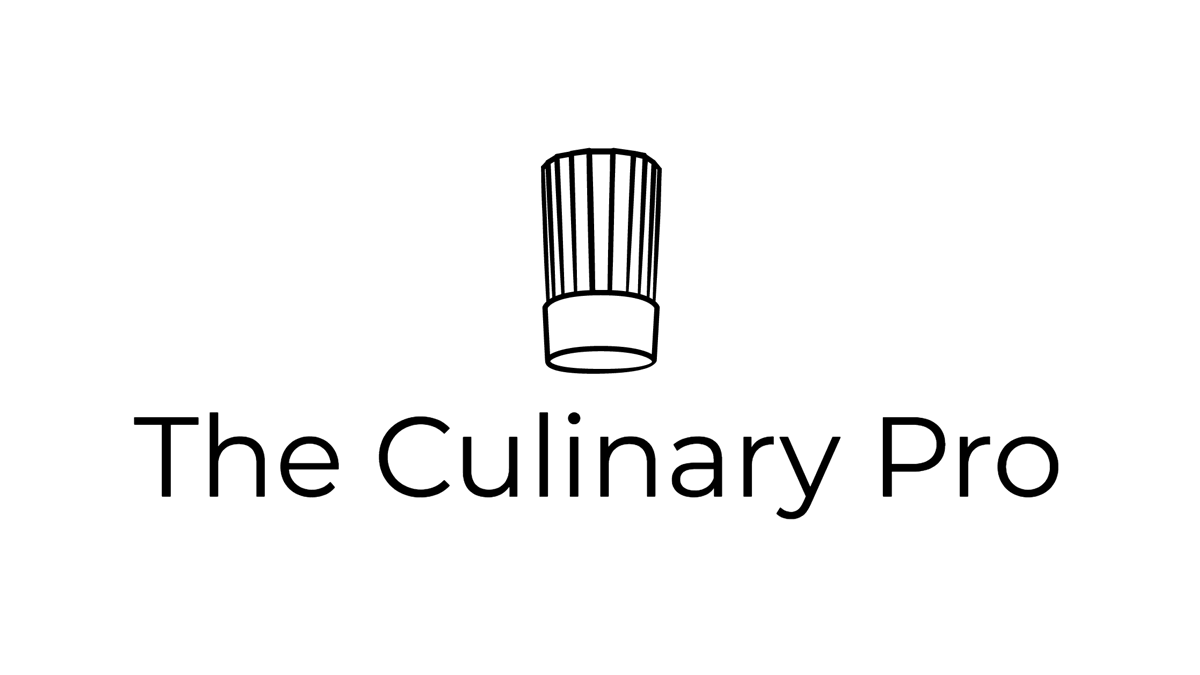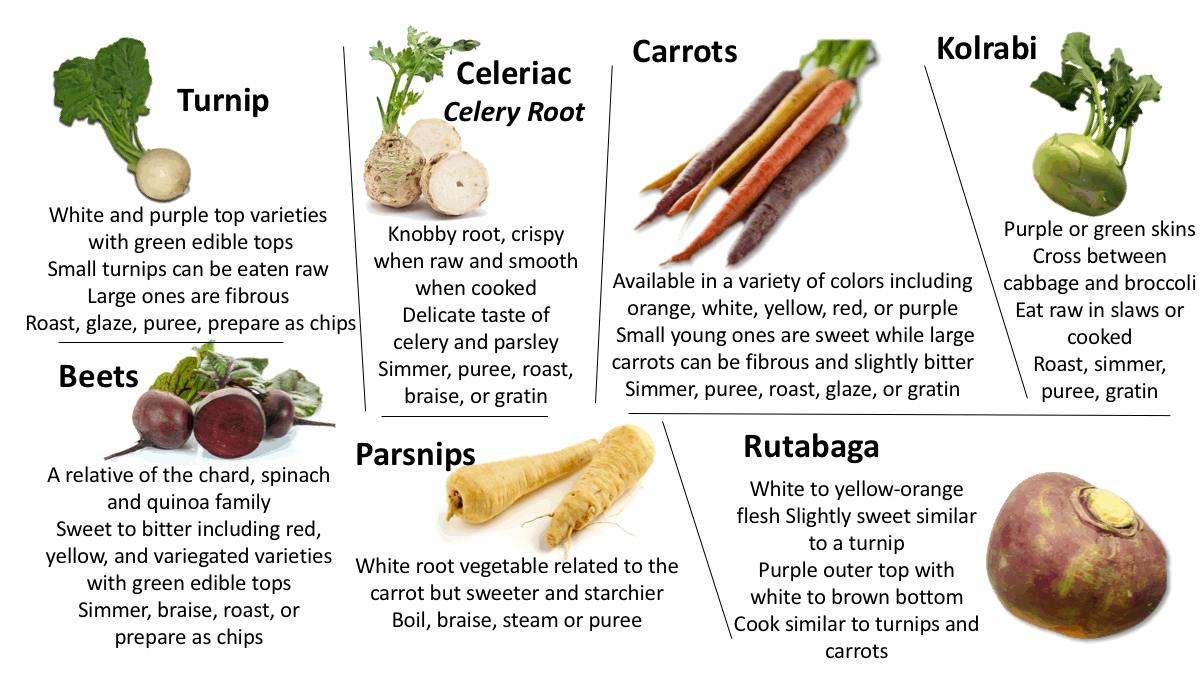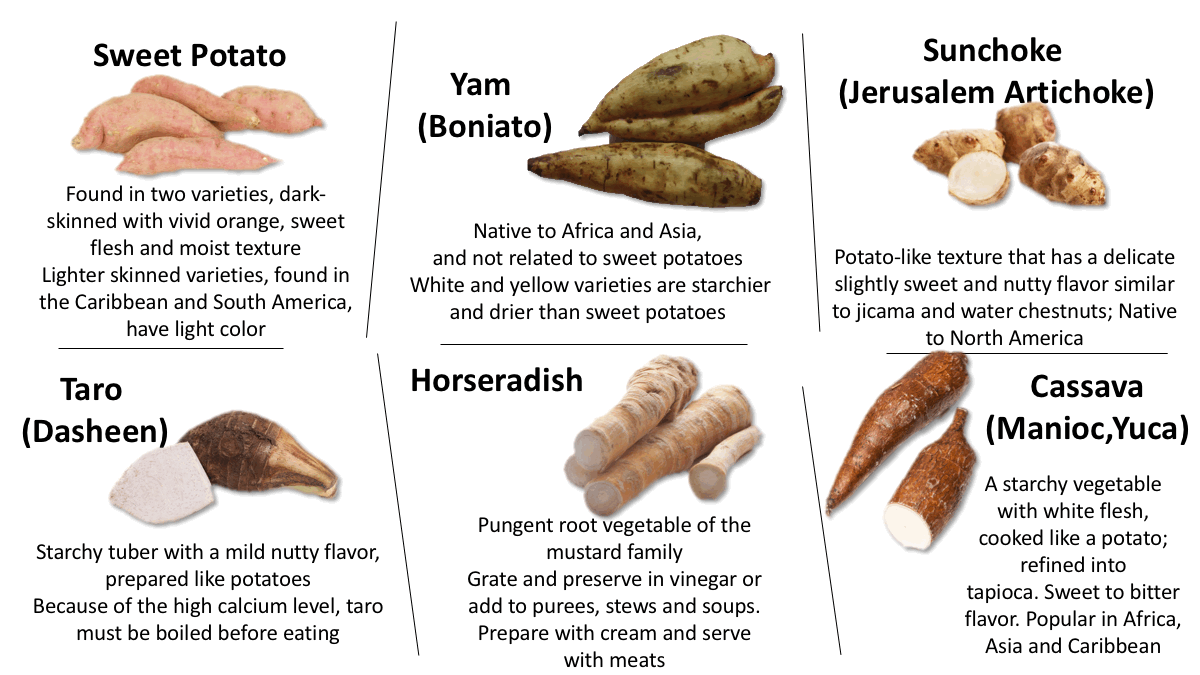Root & Tuber Vegetables
Root and tuber vegetables are the underground storage system of various plants found around the globe and include potatoes, yams, sweet potatoes, turnips, rutabagas, and celery roots (celeriac). Potatoes, first cultivated in South America, come in various colors, shapes, sizes, and textures. Other tubers popular in tropical climates in the Caribbean, South America, Polynesia, and Western Africa include manioc (cassava), taro (dasheen), and malanga (yautia).
Some root and tuber vegetables, including raw potatoes, parsnips, and celery root, oxidize when peeled and should be held in water until cooked. Citric acid can also be added to help keep them from discoloring.
Root and tuber vegetables are cooked to soften textures and make them digestible. Moisture and starch content determine the best method, whether simmered, baked, or roasted. Frying in fats adds flavor, texture, and color. Once cooked, color pigments are relatively stable. Other root and tuber vegetables possess similar traits as potatoes and may be substituted for them in many preparations.
POTATOES
There are thousands of varieties of potatoes, but they generally fall into three categories: new or waxy, mature or starchy, and all-purpose. Matching the potato characteristics to the best cooking method will yield the most consistent results in the kitchen.
New Potatoes are any variety of potatoes harvested in the spring or summer with high moisture and low starch content. They are sometimes called waxy potatoes and are best when steamed, roasted, or grilled.
Mature Potatoes are Russet Potatoes harvested in the fall with low moisture and high starch content. Because of this high starch content, the potato granules swell and break into dry granules that are easy to mash and puree. They are suitable for baking, pureeing, and frying.
All-Purpose Potatoes, including large red, white, and yellow varieties, have moderate moisture and starch content and are suitable for diverse preparations. All-purpose potatoes hold their shape after cooking and are used in salads, soups, and casseroles. They are also ideal for boiling, steaming, frying, and roasting.
OTHER TUBERS AND ROOT VEGETABLES
Unrelated to the common potato, sweet potatoes are suited more for slow, dry-heat cooking that turns the starch into maltose and gives them a sweet flavor. Yams are a distinct species separate from American sweet potatoes that are dry and mealy. Most yams in the US are sweet potatoes and not real yams. In the Caribbean, Central, and South America, boniato and batata are white sweet potatoes.
Other root and root-like vegetables, including carrots, parsnips, rutabaga, turnips, and celery root, contain less starch but can be cooked using the same potato preparations. The following chart includes root vegetable descriptions, flavor profiles, and recommended cooking methods.
Starch & Sugar in Vegetables
Young vegetables, in general, have higher levels of sugar and lower levels of starch. As vegetables mature, the sugar is converted to starch. Roots and tubers, when harvested and stored, become starchier and, therefore, more fibrous. Cooking methods and cooking times should be adjusted to compensate for this disparity. Some vegetables, like mature carrots, may need added sugar to compensate for their lack of sweetness. Experimenting with textures and flavors while being conscious of basic taste sensations will yield the best results.
Moist Heat Cooking Methods
Vegetables cooked by moist heat methods are simple in their preparation and presentation. They can be served by tossing with butter or oil, fresh herbs, salt, and seasoning. Moist heat cooking methods are used as a mise en place step for other finishing techniques, including roasting and frying.
Steamed & Simmered
Roots and tubers, when steamed or simmered, can be cooked in their skins, peeled and cooked whole, sliced, diced, or tournéed. Cooking vegetables in their skins retains more nutrients and flavor but is sometimes impractical in production. Steamed and simmered potatoes are used for purees, gnocchi, flatbread dough, potato salads, stews, and casseroles.
Best Choice: New potatoes, all-purpose potatoes, red skin, and yellow skin varieties.
Method
Scrub potatoes
Remove eyes, sprouts, and green spots.
Peel if desired.
Cook whole or cut into uniform shapes for even cooking.
Submerge in cold water to prevent discoloration.
Start potatoes in cold water (hot water promotes uneven cooking and mealy potatoes).
Add salt to the water, 1 oz./28 g per 1 g/4 l of water. For par-cooked potatoes, increase the salt level.
Cook at a simmer to retain the integrity of the potatoes.
Check for tenderness with a fork or skewer; avoid overcooking.
Drain immediately, oven dry if using for purees, toss with butter/ oil and seasoning, or cool for later use.
Pureed, Mashed, Whipped, & Duchesse
Best Choice: Russet, yellow skin potatoes
Method
Cook potatoes by the moist heat method.
Drain and oven dry
Process through a food mill.
Using a mixer with a paddle or by hand gently whip the potatoes.
For whipped/mashed potatoes add milk/cream, butter, and seasoning
For Duchesse potatoes add egg yolks, butter, and seasoning.
For Pommes Lorette add equal parts pate a choux. Pipe into shapes and deep-fry.
Glazed Vegetables
Glazing can be done with almost any vegetable but is well suited for root vegetables like carrots, parsnips, turnips, and rutabagas. Because each vegetable cooks up differently, glazing them separately and combining them after cooking is best. When glazing vegetables, the goal is to reduce the liquid, butter, and sugar to a syrupy-like consistency when the vegetables are cooked al dente.
Since vegetables are mostly water, adding too much liquid will create a boiled vegetable effect. Therefore, starting with minimal water and adding more as needed is better.
Two different prep techniques can be used depending on kitchen production demands.
Classic Glazed Vegetables
Method
Cut vegetables into uniform shapes.
Combine in a sautoir or braising pan with salt, butter, and sugar.
Add a small amount of water to coat the vegetables. Avoid drowning the vegetables in water because the result will be boiled vegetables rather than glazed.
Heat the vegetables on the stovetop and toss them to coat them with the liquid.
Cover with parchment and allow to cook until tender but not soft. Toss the vegetables periodically. Add more liquid as needed.
If prepared correctly, the liquid in the pan will reduce to a syrup glaze just as the vegetables have finished cooking.
If the liquid is too watery, strain and reduce it separately, and then add it back to the vegetables.
Glazed Vegetable Production Method
Prepare a simple syrup glaze using equal parts water and sugar heated together to dissolve the sugar.
Cut vegetables into uniform shapes.
Cook vegetables in boiling salted water until 75% cooked. The vegetables should still have a slight bite in texture.
Cool in ice water and drain well.
Sauté in batches with butter or oil as needed; add glaze and seasoning to finish.
Gratinée & Casserole
Potatoes cooked en casserole are combined with milk, cream, savory custard, stock, or sauces. They are often gratinéed with grated cheese or bread crumb crust to add color and texture to the finished dish. The potatoes are sliced either in a raw or par-cooked state, layered in a buttered dish, and then covered with the liquid before baking.
Best Choice: Russets, yellow skin varieties
Method
Scrub and peel potatoes, and par-cook if desired.
Assemble all ingredients for rapid prepping.
Heat liquids, cream, sauce, stock, or custard to speed up cooking.
Slice potatoes ⅛” thick on a mandolin; hold in water to prevent discoloration.
Dry potatoes thoroughly; excess moisture will affect flavor, seasoning, and texture.
Season the potatoes with salt and pepper.
Butter a casserole dish or hotel pan and rub with raw garlic.
Layer the potatoes in the pan.
Pour the hot liquid over the potatoes to cover the surface.
Cover with buttered parchment and foil.
Bake in a water bath at 325˚F/160˚C until almost tender.
Remove foil and parchment, and top with grated breadcrumbs or grated cheese (Parmesan, Gruyere, or other hard-grating cheese).
Return to oven to brown the surface.
Cut and serve immediately.
Production Cooking Method
If not using, remove the casserole from the oven before browning the surface and rapidly cool.
Set another hotel pan with a weight on the top of the casserole to compress the layers.
To reheat, remove foil and parchment, and top with grated breadcrumbs or grated cheese (Parmesan, Gruyere, or other hard-grating cheese).
Return to oven to re-thermalize and brown the surface.
Pommes Pavé
Method
Square off potatoes and slice on mandolin.
Season with salt and pepper.
Layer side by side in a pan lined with buttered parchment.
Cover with foil and bake until tender.
Weight down and cool completely.
Remove from pan and cut into squares.
Sauté until browned on all sides.
Dry Heat Cooking Methods
Fried & Sautéed
A standard potato preparation that includes classic French to rustic American traditions with many assorted variations provides a hearty accompaniment to roasts, steaks, and egg dishes.
Best Choice: Red skin and yellow skin varieties
Pommes Lyonnaise
Home fries, also called American or Cottage Fries, Lyonnaise, and Sardalaise, are all sliced potatoes fried or sautéed in fat. The potatoes are often blanched, whole or after slicing, before the final pan-cooked step. Some recipes call for caramelized onions; others vary the fats from oil to butter to duck or goose fat. These recipes can be garnished with the addition of garlic, bacon, peppers, mushrooms, spices, and fresh herbs. Contemporary twists can be prepared with root vegetables.
Method
Blanch potatoes, either whole or pre-sliced, until about half cooked.
Drain and oven-dry potatoes to remove excess moisture.
Caramelize the sliced onions in sauté pan; remove from pan and reserve.
Add potatoes and sauté stirring occasionally to brown on all sides.
Add the onions to the potatoes and season with salt and pepper
Garnish with chopped parsley
Potato Pancakes & Latkes
Shredded potatoes formed into cakes and fried are known by different cultural names. These preparations can be served as appetizers with smoked salmon, sour cream, caviar, chives, or applesauce. They can also be served as side dishes for breakfast entrees or with steaks, chops and roasts.
Method
Scrub potatoes and peel if desired.
Simmer whole and par-cook until half done.
Drain and cool, peel if needed.
Shred potatoes, toss with a little lemon juice to prevent discoloration. Place potatoes in a colander or strainer and squeeze out excess moisture.
Combine with onions, salt, pepper, eggs, flour and parsley.
Check the consistency and seasoning by frying a sample.
If the mixture becomes waterlogged, add more flour.
Heat a sauté pan and add oil to cover the pan by about ⅛”.
Spoon the mixture and flatten slightly to create a round pancake.
Brown until crisp on one side and flip to brown on the opposite side.
Serve immediately.
Hash Browns & Rӧsti Potatoes
Hash Browns
Cooked and shredded potatoes are the characteristics of American hash browns and rӧsti potatoes. Hash browns can be prepared free-form or shaped in a small individual cake. Some variations of hash browns are diced or sliced. Rӧsti are large pan-size cakes that are turned out and portioned in wedges when finished. Like other fried potato preparations, they can be varied with different garnishes and using different root and tuber vegetables.
Best Choice: Russets
Method
Rӧsti Potatoes
Scrub potatoes, peel if desired.
Simmer in salted water until half cooked.
Drain and dry in oven.
Cool and peel potatoes if needed.
Coarse grate potatoes
Heat a cast iron skillet or sauté pan. Add oil or clarified butter.
Layer the potatoes evenly in the pan. For hash browns make individual portions; for rӧsti make one large cake.
Season with salt and pepper.
Cook until the potatoes are and even golden brown and flip the cake.
Brown the opposite side and cook until crisp on the outside and tender on the inside.
Remove from pan; for the rӧsti cake cut into servings and serve immediately.
Pommes Anna & Galette de Pommes de Terre
These are sautéed variations using sliced and layered potatoes.
Best Choice: Mature reds, yellow skin varieties
Method
Pommes Anna
Scrub, peel, and clean the potatoes.
Slice on a mandolin no more than ⅛” thick
Butter a sautoir and layer the potatoes in concentric circles. Season and butter each layer.
Cover the potatoes with a butter parchment cartouche( French term for a false lid).
Begin cooking on the stovetop to brown the bottom layer of the potatoes. Turn the potatoes if desired.
To compress the cake, weigh the potatoes down with another sauté pan or skillet.
Place in a moderately hot oven 400˚F/200˚C and continue for about 30 minutes or until tender.
Turn out the cake onto a platter and portion into wedges.
Alternately, layer the potatoes on a sheet pan and bake directly in a hot oven.
Pommes Frites, Chips & Gaufrettes
Plunging starchy vegetables in hot fats provides crispy textures, a salty bite, and a savory mouth feel that immediately appeals to primal taste sensations. Pommes frites is a French export that is universally popular around the globe. Chips and gaufrettes, thin and crisp variations, are equally popular and can be prepared with any root vegetable.
Best Choice: Russets
Pommes Frites
Deep-fried potatoes are best when fried twice. The first is a blanching stage at a temperature of 300-325˚F/150-160˚C to soften their texture. The finishing stage at 350-375˚F/175-190˚C completes the cooking process, providing a crisp texture and golden brown color.
Method
Scrub and trim potatoes, peel if desired, and cut into uniform julienne shapes on a mandolin.
Soak in cold water until ready for cooking.
When ready to fry, drain the potatoes well and blot dry on paper towels.
Drop into a deep-fryer at 300-325˚F/150-160˚C for a few minutes to soften the potatoes. Spread out on a sheet pan lined with parchment paper.
The potatoes can be kept cooled or frozen until ready for finishing
To finish, drop in a fryer at 350-375˚F/175-190˚C and cook until crisp and golden brown.
Sprinkle with salt and serve immediately.
Ultimate Pommes Frites
This method of blanching in acidulated water provides a perfect crisp pommes frites. The key to this blanching technique is the addition of vinegar to the water and maintaining the water temperature at 160˚F/70˚C, which prevents the potatoes from falling apart.
Method
Scrub and trim potatoes, peel if desired and cut into uniform julienne shapes on a mandolin.
Soak in cold water until ready for cooking.
Combine water, vinegar, and salt in a large pot. Add the potatoes.
Bring the water to a temperature of 160˚F/70˚C and maintain the temperature until the potatoes are just cooked through, about 10 minutes.
Drain well and spread out on sheet pans lined with parchment paper. The potatoes can be stored in the cooler or frozen until use.
To finish, drop in a fryer at 350-375˚F/175-190˚C and cook until crisp and golden brown.
Sprinkle with salt and serve immediately.
Chips & Gaufrettes
The key to perfect vegetable chips is ultra-fresh oil and the correct frying temperature. Because of the sugar content in vegetables like sweet potatoes maintaining a low fryer temperature averts the chips from getting too dark or bitter tasting.
Method
Scrub, peel and trim vegetables.
Slice on a mandolin 1/16” thick.
Soak in cold water until ready to cook.
Drain vegetables and pat dry
Deep fry at 300-325˚F/150-160˚C until crisp
Baked & Roasted
To bake and to roast are different names for the same process. The terms are assigned based on traditioal use and to create menu variety and interest.
Best Choice: Russets
Baked
Baking is a simple yet delicious method for cooking potatoes. This method can also be used for any type of root vegetable cooked whole in their skin.
Method
Scrub potatoes; pierce them lightly with a fork a few times.
Brush with oil if desired.
Sprinkle a generous even layer of salt on a parchment lined sheet pan.
Place potatoes on sheet pan.
Roast potatoes at 350˚F/200-180˚ until soft
Serve immediately or hold warm for service
Twice-Baked Potatoes
A hybrid technique of baked and pureed potato preparation techniques
Method
Roast potatoes and allow the potatoes to cool.
Slice the top of the potato off lengthwise.
Carefully scoop out the insides, leaving about ¼ inch of potato on the skin.
Puree the potatoes using the standard puree technique and substitute sour cream for milk. Add other garnishes as desired, such as cheddar cheese, bacon, chives, etc.
Place in a pastry bag and pipe into potato shells
Garnish with parmesan cheese, paprika, or other topping.
Bake in a moderate oven 350˚F/200-180˚ until hot.
Roasted
Roasting is a versatile method for cooking almost any type of root vegetable. Roasting concentrates the flavor and creates a pleasing crisp texture through the Maillard browning process that develops the natural sugars in the vegetables. Blanch the vegetables to speed up the roasting process.
Best Choice: Russets, new potatoes, red skin, yellow skin varieties
Method
Scrub potatoes or root vegetables and peel them if desired.
Cut vegetables into uniform shapes.
Blanch vegetables in salted water if desired.
Toss with seasoning and coat with oil.
Roast in a moderately high oven 400- 425˚F/200-218˚C until tender and brown.
Oven-Roasted Vegetable Chips
Healthy alternatives to deep-fried chips are simple preparations made with various root or tuber vegetables.
Method
Scrub and peel vegetables.
Slice on a mandolin not more than ⅛” thick
Lay out the vegetables on a lightly oiled parchment-lined sheet pan.
Season with salt, pepper, or other spices, and brush the tops with oil.
Roast in the convection oven at 275˚F/135˚C for about 30 minutes until crisp, rotating the pan halfway through the cooking process.
Grilled
The grilling process can cook all types of roots and tubers. Because of the sugar content in some vegetables, including sweet potatoes and carrots, parcooking before grilling can speed the process.
Method
Scrub and peel vegetables.
Cut into ¼ “slices, wedges, or other shapes. For new potatoes or other small root vegetables, split them in half.
Season and oil the vegetables. Add additional herbs and spices if desired.
Grill on indirect heat, turning to score the vegetables with cross-hatched markings.














